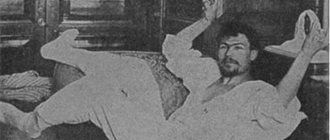Stupor is a movement disorder characterized by immobility, mutism (silence), and lack of response to external stimuli, including painful ones. Literally translated from Latin it translates as “numbness” .
Most often, when talking about stupor, they mean an extreme manifestation of this condition, which should be treated by a psychiatrist in a hospital setting, or the highest degree of confusion, when a person, as they say, cannot utter a word . In fact, stupor is all of the above and many more intermediate states. It can occur to us once in a state of extreme excitement, or it can be repeated with enviable regularity.
Sometimes we can cope with stupor on our own, but more often we need the help of a specialist - a qualified psychologist who will either deal with the situation himself or refer us to a general practitioner or a psychiatrist.
Catatonic stupor
The most common type of pathology, characterized by the patient's numbness in a position with awkwardly bent limbs. That is, the position of the body is not entirely characteristic of a person. The patient stops contacting others, does not pay attention to what is happening around him, as if under hypnosis, even if the situation poses a clear threat to life.
The most striking examples characterizing catatonic stupor and what it is are, for example, cases when the patient remained lying in an unnatural position in a room engulfed in fire, without showing any signs of anxiety and without reacting to pain. Anyone can fall into a stupor under stress.
This manifestation of catatonic syndrome begins, as a rule, with the masticatory muscles, later descending to the cervical region, and ends with numbness of the limbs. Such nervous paralysis can be caused by any stressful situation, for example, fear, shock, fright.
How to bring a person out of a stupor
If a person has fallen into a stupor, you can try to bring him out of this state using simple methods:
- in a quiet and even voice, tell him things that should evoke a strong emotional reaction - both positive and negative;
- press all fingers , except the thumb, firmly to the palm;
- Give a few hard slaps .
In some cases this is enough.
Note! Even if a person comes out of his stupor after such events, he needs to consult a specialist. If the numbness does not go away, the patient must be hospitalized.
The following are used to treat stupor:
- neuroleptics;
- psychostimulants;
- relaxers.
This therapy is carried out only in a hospital under the supervision of a doctor .
Photo 2. In more complex situations, medication and medical supervision may be needed. Source: Flickr (kiril pipo).
Types of stupor and its symptoms
In severe cases, a person experiences total immobility, accompanied by the absence of any reaction to any external stimuli, even painful ones. Muscle tone in such patients is increased or, conversely, decreased. In some types of stupor, waxy flexibility may develop.
Depending on the reasons that caused the disorder, a different combination of symptoms may be observed: reduction and distortion of motor and volitional functions.
Stupor is sometimes a symptom of reactive psychoses, schizophrenia and organic damage to the central nervous system.
Stupor with waxy flexibility is caused by the patient having mutism, immobility, and the ability to maintain a certain position for a long time. Patients do not want to communicate, but at night they can eat, answer questions, or take care of themselves.
Negativistic stupor is manifested by the fact that a person refuses to eat, talk, and attempts to change the position of his body cause sharp resistance.
Stupor with muscle numbness is manifested by the fact that the patient assumes a fetal position, the muscles of such patients are tense, the lips are slightly elongated, and the eyes are closed. Such patients may refuse to eat, so they receive feeding through a feeding tube.
Depressive stupor is caused by complete immobility; such patients have a pained expression on their face; if you manage to come into contact with them, they give monosyllabic answers. Sometimes this type of stupor is replaced by sudden excitement or melancholic raptus, in which case patients tend to cause serious harm to themselves.
Apathetic stupor is expressed by the fact that patients lie on their backs, they are detached from the outside world, answering all questions in monosyllables with some delay. This type of stupor occurs during psychosis or Wernicke's disease.
Catatonic stupor is associated with freezing in fear or numbness in fear, freezing in fear. Such patients refuse to talk and eat and tend to freeze in one position for a long time.
Before moving on, let's take a quick look at the types of stupor and give them a very brief description. So, there is a stupor:
- Akinetic. This condition is characterized by maintaining the body position in one position for a long time and resisting its change.
- Apathetic. It is characterized by a lack of motivation for any activity, both motor and mental, disorientation, and paucity of experiences.
- Affective, depressive, melancholic stupor. It is observed with deep depression and is usually accompanied by a mournful expression on the face and posture.
- Hallucinatory or hallucinatory-paranoid stupor is accompanied by hallucinations, either auditory or visual.
- Catatonic. It is a manifestation of catatonic syndrome and is characterized by passive negativism or waxy flexibility, and in the most extreme manifestation – muscle numbness in the fetal position.
- Manic. Combined with the patient's extremely agitated mood.
- Negativistic. In this state, the patient is in a daze, but resists attempts at external influence.
- Effective or empty. There are no other psychopathological disorders.
Causes of stupor
Possible causes of stupor include:
- mental illness;
- diseases of the nervous system.
This condition can be a consequence of severe depression and prolonged psychosis, neuroses, and schizophrenia . It also develops as a result of encephalopathies and brain damage due to infectious diseases, intoxication and trauma.
Impressionable and emotionally unstable people often fall into a stupor after they experience some kind of shock or become witnesses or participants in emergency incidents.
Note! Knowing the reasons for the development of stupor, you can reduce the likelihood of developing this condition to a minimum. To do this, it is necessary to avoid stress and situations that traumatize the psyche, as well as promptly treat mental and neurological diseases.
Stupor causes, methods of diagnosis and treatment
Stupor is a physical and mental disorder expressed in the form of numbness, as well as partial or complete immobility. Most often accompanied by mutism - the inability or unwillingness to contact others with complete preservation of thinking and speech abilities. A symptom is a person’s condition in which he does not react to external stimuli, does not experience hunger, temperature changes, pain or other sensations.
When diagnosing stupor, the presence or absence of a state of immobility in the patient, a decrease or absence of reaction to external stimuli is taken into account. Also, when making a diagnosis, it is necessary to take into account whether the patient has recently suffered a stressful event.
Treatment of stupor with homeopathy
Homeopathic medicines are selected based on the patient's condition.
- Rhus toxicodendron is used to treat patients with numbness and stupor, who are slow in answering questions and are quietly delirious.
- Nux vomica (Nux moschata) is used to treat stupor with loss of sensation, in which the patient is irresistibly drawn to sleep.
- Hyoscyamus (Hyoscyamus niger) is used to treat patients who easily come out of torpor, but quickly return to this state.
- Papaver somniferum is used for numbness, which is accompanied by loss of sensitivity and absolute indifference to what is happening, with the risk of developing apoplexy and coma.
- Belladonna is used in patients who have difficulty getting out of a stupor and then become violent, tearing clothes, rushing about and showing aggression.
- Phosphorus (Phosphorus) is indicated for stupor, during which the patient responds sluggishly to questions or leaves them unanswered.
- Phosphoric acid (Acidum phosphoricum) - used to treat patients who are in a sleepy stupor, but regain consciousness after waking up.
- Apis mellifica is used for complete torpor.
Stupor: causes of the disease, main symptoms, treatment and prevention
Emotional disorders
29.11.2017
7 thousand
4.7 thousand
6 min.
Stupor is a condition in which a person does not move and does not respond to external stimuli. This is a psychiatric pathology that occurs with severe shock.
There are many types of stupor, differing in symptoms and causes. To get out of this state, a person needs the help of relatives.
In some (especially severe) cases, consultation with a psychiatrist and even medication are required.
Stupor in medicine is a dissociative disorder that is accompanied by a state of numbness.
It is characterized by immobility combined with a quality such as mutism (muteness or refusal of all kinds of communications), a weak reaction to irritating stimuli.
The individual does not pay attention to events around him, including pain, noise or cold. A person goes without food for a long time, does not speak, and often freezes in one position.
Stupor becomes the outcome of depression, mental disorders, and stress.
Many patients may lie down, not change their position, refuse to eat, or not answer questions for several days or even weeks. Patients are able to stand in one unnatural position.
The main factors causing the condition:
- severe traumatic event;
- stressful situation;
- mental disorder;
- emotional negatively colored situation;
- organically determined damage to the brain structure;
- intoxication;
- bruise or concussion;
- infectious diseases.
According to some experts, a deficiency of gamma-aminobutyric acid, located in the brain, causes disorders of the musculoskeletal system, which is the main symptom of catatonic stupor.
Considering the syndrome in animals in stressful situations (the victim is afraid of the predator), the researchers noted that under the influence of fear the body is tuned to imminent death. This is the reaction that persists in people. Based on this assumption, catatonic syndrome can manifest itself in patients with schizophrenia who are in a state of irresistible fear.
Symptoms
To define a disorder of consciousness, you need to give it criteria. To do this, two levels of functioning are compared: clear consciousness and impaired consciousness.
Clear consciousness: a person has criticism towards himself, reflects the surrounding reality and reacts to it with all possible range of emotions and behavior.
Criteria for impaired consciousness:
- The person is detached from the outside world. He doesn't perceive reality.
- The person is disoriented in time and geographical location. Often he is disoriented in his own personality.
- Impaired thinking: cause-and-effect relationships are incorrectly established.
- Congrade amnesia - during stupor, memories of events are repressed.
If these 4 points are observed, the patient’s consciousness is impaired.
Numbness is characterized by typical symptoms that are independent of the disease. That is, stupor in ischemic stroke or renal-liver failure manifests itself in the same way.
Mental signs of stupor:
- disorientation: the patient does not answer the question about place of residence, time; he cannot say his name or where he is now; communication with a numb patient can be compared to communication with a monument;
- no reaction to higher sensory stimuli: the patient does not react to loud sounds or bright lights.
The concept of stupor includes two options for its course:
- Hyperkinetic option. Psychomotor and speech agitation is characteristic. The patient changes his body position within the bed, mutters, and shouts something.
- Akinetic option. The opposite of the previous one: there is no speech and thinking.
Neurological status during stupor:
- decreased skeletal muscle tone;
- pretentious poses in bed;
- face without facial expressions;
- there is a reaction of the pupils to light, a weak reaction to pain (the patient may twitch when given an injection);
- There are protective reflexes: corneal and conjunctival.
- weakened tendon reflexes;
- basic reflexes are preserved: sneezing, coughing, gagging and swallowing.
Patients recover from stupor gradually. If the condition improves, then consciousness moves upward according to the pattern: moderate stun → mild stun → clarity. If it worsens, then to the bottom: stupor → coma. If a person has emerged from stupor to clarity, this does not mean that he has been cured. The cause may recur, such as kidney or liver failure.
After the coma, there is a deterioration in degree: coma I → coma II → coma III → coma IV → near-death state → death. In case of relief: coma → stupor → stupor → clarity.
How long the torpor lasts: depends on the cause - from several days until death.
Depressive stupor
Depressive stupor - what is it? Another condition that psychiatry history knows very well. Depressive stupor is a consequence of severe endogenous depressive disorders. In addition to numbness, it is characterized by a pained or melancholic expression on the patient’s face.
However, he continues to take care of himself, to carry out everything
functions and sometimes even makes contact. Often, numbness and detachment are replaced by unexpected bouts of activity and bursts of energy. Suffice it to remember how grief or depression is depicted in films: the hero, sitting by the window, looks at one point. At the same time, he can drink tea or smoke, seeking salvation and peace in this.











